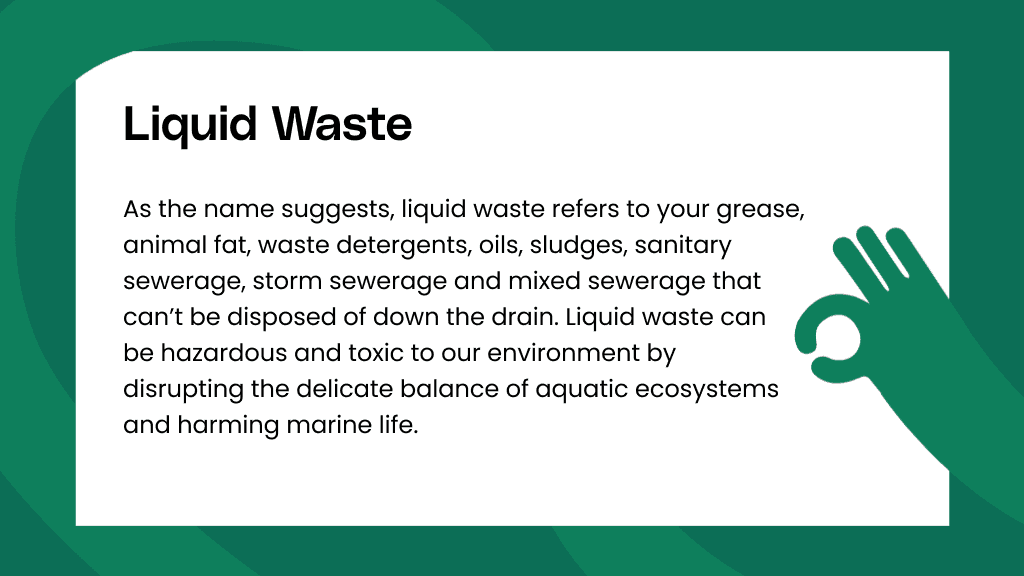How Reclaim Waste can Save You Time, Stress, and Money.
How Reclaim Waste can Save You Time, Stress, and Money.
Blog Article
Not known Details About Reclaim Waste
Table of ContentsAll about Reclaim WasteThe Best Guide To Reclaim WasteSome Ideas on Reclaim Waste You Should KnowNot known Details About Reclaim Waste An Unbiased View of Reclaim Waste
Domestic sewage waste refers to the waste and products from a residential septic storage tank. The proper monitoring and disposal of residential sewage waste require fluid waste to be moved to a sewer therapy plant where the proper techniques and equipment are used to purify and dispose of waste.
Commercial waste often includes possible risks, such as flammable materials or a mix of fluid and strong waste products, and needs an advanced and comprehensive disposal procedure. The disposal of business waste normally includes the filtering of waste prior to transport to guarantee safe and correct disposal. Industrial waste is produced from by-products and drainage of commercial processes and manufacturing.
This sort of waste can not utilize the exact same sewage monitoring transportation or processes as septic or commercial fluids. The commercial waste administration process needs the evaluation and screening of fluid waste before it undergoes the disposal procedure (industrial wastewater treatment). Overflow waste is the fluid waste that originates from drainage and excess stormwater in extremely inhabited areas or cities
Overflow waste can cause contamination and flooding if not dealt with effectively. Making sure proper waste management can stop calamities and decrease ecological harm.
8 Easy Facts About Reclaim Waste Explained
Get in touch with PROS Solutions today to discover our waste monitoring and disposal services and the correct methods to look after the liquid waste you create.
(https://www.easel.ly/browserEasel/14532007)This so-called 'wastewater' is not just an essential source but, after treatment, will certainly be launched to our land, rivers or the sea. Used water from commodes, showers, baths, cooking area sinks, laundries and commercial procedures is recognized as wastewater.

water used to cool down machinery or tidy plant and devices). Stormwater, a kind of wastewater, is overflow that streams from agricultural and urban areas such as roofings, parks, yards, roads, paths and seamless gutters right into stormwater drains, after rain. Stormwater flows without treatment directly to regional creeks or rivers, ultimately getting to the ocean.
The Reclaim Waste Ideas
In Queensland, many wastewater is dealt with at sewage therapy plants. Wastewater is transported from residential Visit Website or commercial sites via a system of sewage systems and pump terminals, called sewerage reticulation, to a sewage therapy plant. Regional governments construct, preserve and operate most sewer therapy plants. Operators are licensed under the Environmental Defense Act 1994 to release cured wastewater at an acceptable ecological criterion into waterways.
The Department of Natural Resources advises city governments regarding managing, operating and keeping sewerage systems and treatment plants. In unsewered areas, local federal governments may need owners to install individual or house sewage therapy systems to treat residential wastewater from bathrooms, cooking areas, bathrooms and laundries. The Division of Natural Resources authorises using household systems when they are proven to be reliable.
The majority of stormwater obtains no treatment. In some new communities, treatment of some stormwater to eliminate trash, sand and crushed rock has actually started utilizing gross contaminant traps. Wastewater therapy happens in 4 phases: Gets rid of strong issue. Larger solids, such as plastics and various other things mistakenly discharged to sewage systems, are eliminated when wastewater is passed via screens.
Wastewater then moves into huge containers where solids settle and are gotten rid of as sludge. Oil and residue are skimmed from the surface. Uses small living microorganisms knows as micro-organisms to break down and get rid of remaining liquified wastes and fine bits. Micro-organisms and wastes are included in the sludge. Removes nitrogen and phosphorus nutrients that can trigger algal blooms in our rivers and threaten aquatic life.
Reclaim Waste - An Overview
Nutrient removal is not available whatsoever sewage treatment plants due to the fact that it needs pricey specialized equipment. It is becoming a lot more common in Queensland. Clear liquid effluent created after therapy may still have disease-causing micro-organisms. If this effluent is launched into rivers such as rivers or the sea, the micro-organisms will at some point die out.

This typically means wastewater has to be treated or pollutants eliminated prior to it can be discharged to waterways. A lot of wastewater streams into the sewerage system. Under the Act, local federal governments carry out authorizations and licences for ecologically pertinent activities (Ages) involving wastewater launches that might have a regional influence. The department carries out approvals and permits to ERAs entailing wastewater launches that may have a regional or statewide effect.
The smart Trick of Reclaim Waste That Nobody is Discussing
Or else, samples are taken for lab evaluation. Frequently numerous examinations are needed to develop the levels of each of the different pollutants such as oils, hefty steels and chemicals in water. Surveillance provides valid information regarding water top quality and can validate that permit conditions are being satisfied. The information obtained via surveillance supplies the basis for making water high quality choices.
Report this page